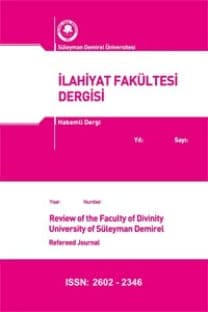İSLAMİ ŞEHİR, MEDENİYET VE NOSTALJİNİN SİYASETİ
İslami şehir, siyaset ve nostalji
THE ISLAMIC CITY, CIVILIZATION and THE POLITICS of NOSTALGIA
Islamic city civilization, politics and nostalgia,
___
- Abu-Lughod, J., “The Islamic City: Historic Myth, Islamic Essence and Contemporary.
- Bozdoğan, S. & Akcan, E. Turkey: Modern Architectures in History, London: Reaktion Books, 2012.
- Brown, C. (ed.) From Madina to Metropolis: Heritage and Change in the Near Eastern City, Princeton: The Darwin Press, 1973
- Burdett, R. & Sujdic, D., Living in the Endless City, London: Phaidon, 2011.
- De Young, T. Placing the Poet, Badr Shakir al-Sayyab and post-colonial Iraq, Albany, 1998.
- Besim S. Arabic-Islamic Cities: Building and Planning Principles, London: Kegan Paul International, 1986.
- Elsheshtawy, Y., The Evolving Arab City: Tradition, Modernity & Urban Development, Abingdon: Routledge, 2008.
- Faroqhi, S., Men of Modest Substance: House Owners and House Property in Seventeenth-Century Ankara and Kayseri. Cambridge: Cambridge University Press, 1987.
- Ibn Khaldun, The Muqadimmah, trans. F. Rosenthal, Princeton, 1967
- Lapidus, Ira (ed.), Middle Eastern Cities, Berkeley: University of California Press, 1969.
- -------- 'Traditional Muslim Cities: Structure and Change, in L. Brown (ed.) From Madina to Metropolis: Heritage and Change in the Near Eastern City, 51-72, 1973.
- ------ An introduction to classical Islamic philosophy, Cambridge, 2002.
- ------ “Mecca” in Encyclopedia of Urban Cultures, ed. M. & C. Ember, Danbury: Grolier, 2002, pp. 152-7.
- ------ Islamic Aesthetics: an introduction, Oxford, 2008.
- Lefebvre, H., The Production of Space, translated by Donald NicholsonSmith, Oxford: Blackwell, 1991.
- Marcus, A. The Middle East on the Eve of Modernity: Aleppo in the Eighteenth Century. New York: Columbia University Press, 1989.
- Morony, M., Iraq after the Muslim conquest, Princeton, 2005.
- Nasr, S. Knowledge and the Sacred, Albany: State University of New York Press, 1989.
- O'Meara, S., Space and Muslim Urban Life: At the Limits of the Labyrinth of Fez (Culture and Civilization in the Middle East). London: Routledge, 2007.
- Ohlander, E., Sufism in an age of transition. ʻUmar al-Suhrawardi and the Rise of the Islamic Mystical Brotherhoods (Islamic History and Civilization vol. 71), Leiden: Brill, 2008.
- Raymond, A. The Great Arab Cities in the 16th–18th Centuries: An Introduction. Hagop Kevorkian Series on Near Eastern Art and Civilization, New York: New York University Press, 1984.
- ------‘Islamic City, Arab City: Orientalist Myths and Recent Views,’ British Journal of Middle Eastern Studies 21 (1994): 3-18.
- Robinson, C. (ed.) A Medieval Islamic City reconsidered, Oxford Studies in Islamic Art XIV, Oxford: Oxford University Press, 2001.
- Saqqaf, A. (ed.) The Middle East City, New York: Parago, 1987.
- Wild, S., “Paradise” in The Qur’an: an encyclopedia, ed. O. Leaman, London, 2006, 486-8.
- Wolper, E. Citizens and Saints: Sufism and the transformation of urban space in medieval Anatolia, University Park: Penn State University Press, 2003.
- Yayın Aralığı: Yılda 2 Sayı
- Başlangıç: 1994
- Yayıncı: Süleyman Demirel Üniversitesi
İBN HALDÛN FELSEFESİNDE TABİAT-İNSAN İLİŞKİSİ
ERDEMLİ ŞEHİR VE HİKMETLİ BİLGİ İLİŞKİSİ
GAZZÂLÎ VE AQUINAS’TA NEDENSELLİK
İSLAM KENTLERİ VE KENTLEŞME OLGUSUNUN GELİŞİMİNDE BİR ODAK NOKTASI OLARAK TEKKELER
HELÂL GIDA OLGUSU VE UYGULAMASINA SOSYOLOJİK BİR YAKLAŞIM: MALEZYA ÖRNEĞİ
İSLAMİ ŞEHİR, MEDENİYET VE NOSTALJİNİN SİYASETİ
CAHİLİYE DÖNEMİNDE ARAP YARIMADASI PANAYIRLARI
ŞEHİR-MÜZİK İLİŞKİSİNE DAİR KURAMSAL DÜŞÜNCELER
XIV. YÜZYIL RİFÂÎ ŞEYHİ İBNÜ’S-SERRÂC’IN VELÂYET VE KERÂMET ANLAYIŞI
Mehmet Necmettin BARDAKÇI, Mehmet Saffet SARIKAYA, Nejdet GÜRKAN
